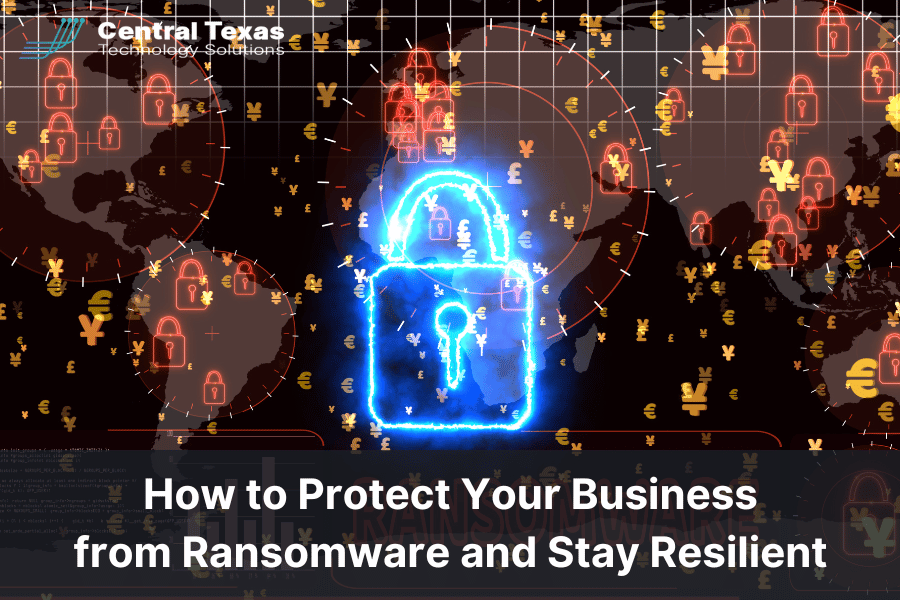
Would Your Business Survive a Ransomware Attack?
Imagine logging into your system only to find that all your company’s data is encrypted, with cybercriminals demanding a ransom to unlock it. The reality is, ransomware attacks are on the rise, targeting businesses of all sizes. The question isn’t if an attack will happen, but when.
Your ability to recover quickly and minimize damage depends on how well you prepare today. This guide will show you how to build cyber resilience and protect your business from ransomware threats.
What Is Cyber Resilience and Why Does It Matter?
Many businesses focus on cybersecurity as a defense mechanism, but cyber resilience goes a step further. Instead of just preventing attacks, it ensures that your business can detect, respond, and recover when a cyberattack occurs.
The four key components of cyber resilience are:
- Preparedness: Develop response plans for ransomware attacks and other incidents. When a crisis hits, clear protocols reduce confusion.
- Detection: Use advanced monitoring tools to identify threats early and take action before the damage spreads.
- Response: Contain the attack and communicate effectively with employees, clients, and stakeholders.
- Recovery: Have backup systems and a tested recovery plan in place to restore operations quickly.
By prioritizing cyber resilience, you reduce downtime, financial losses, and reputational damage—keeping your business secure in an increasingly dangerous digital landscape.
The True Cost of a Ransomware Breach
Ransomware is a type of malware that locks your files and demands payment to restore access. But paying the ransom doesn’t guarantee your data’s safety—cybercriminals may still leak, sell, or delete it.
The potential consequences of a ransomware attack include:
- Financial losses: Costs from downtime, ransom payments, and lost business revenue
- Reputational damage: Loss of trust from customers, partners, and stakeholders
- Data exposure: Stolen or permanently deleted sensitive client and employee information
- Legal penalties: Compliance violations under GDPR, CCPA, and other data protection laws
The impact of an attack can last for months—or even years. That’s why prevention and resilience planning are essential.
How to Defend Your Business from Ransomware
1. Back Up Your Data the Right Way
Having recent and secure backups is your best defense. Follow the 3-2-1 backup strategy:
✅ Keep three copies of your data
✅ Store them on two different media types
✅ Keep one copy offsite (preferably in a secure cloud storage service)
Test your recovery process regularly to ensure backups are reliable when you need them.
2. Train Your Employees to Spot Ransomware Attacks
Cybercriminals often exploit human error to gain access. Reduce this risk by making cybersecurity training part of your company culture. Teach employees to:
✅ Recognize phishing emails and suspicious attachments
✅ Avoid clicking unknown links or downloading unauthorized files
✅ Report unusual activity or system performance issues immediately
A well-informed team is your first line of defense.
3. Secure Every Device and Endpoint
Your network is only as strong as its weakest link. Protect all endpoints—servers, laptops, mobile devices, and IoT devices—by:
✅ Installing antivirus software, firewalls, and endpoint detection tools
✅ Keeping operating systems and applications updated to patch vulnerabilities
✅ Using multi-factor authentication (MFA) for remote access and critical systems
4. Have a Ransomware Incident Response Plan
A structured plan helps your business respond quickly to minimize damage. Your plan should include:
✅ Containment steps – Isolate affected systems to prevent the spread
✅ Communication strategy – Notify employees, customers, and relevant authorities
✅ Recovery roadmap – Restore operations with minimal downtime
Regularly test and update your plan to keep it effective against evolving threats.
Protect Your Business from Ransomware Before It’s Too Late
Ransomware attacks are relentless, but your business doesn’t have to be an easy target. By implementing strong security measures, training employees, and planning for the worst, you can stay resilient and keep your operations running smoothly—no matter what cyber threats come your way.
FAQ: Common Questions About Ransomware and Cyber Resilience
1. What should I do if my business is hit by ransomware?
If you’re attacked, do not pay the ransom—it doesn’t guarantee data recovery. Instead:
- Isolate infected systems immediately
- Notify your IT security team and law enforcement
- Restore your data from backups if available
2. How often should I back up my data?
Ideally, back up your data daily or at least several times a week. Use both cloud and offline storage for added protection.
3. Is my small business really at risk for ransomware?
Yes! Cybercriminals often target small and mid-sized businesses because they tend to have weaker security than large corporations. No company is too small to be attacked.
Contact CTTS today for IT support and managed services in Austin, TX. Let us handle your IT so you can focus on growing your business. Visit CTTSonline.com or call us at (512) 388-5559 to get started!
